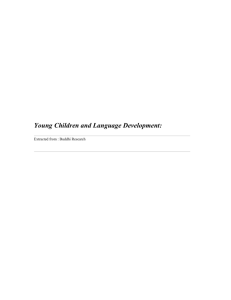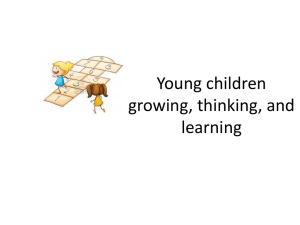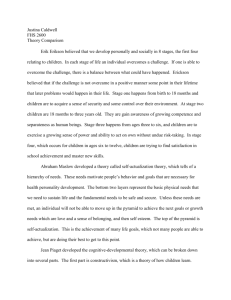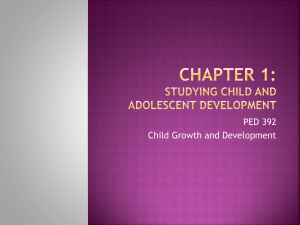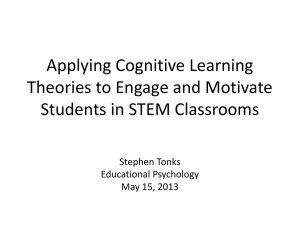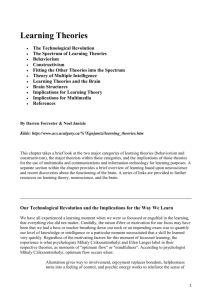Skinner Behaviorist Theories
advertisement
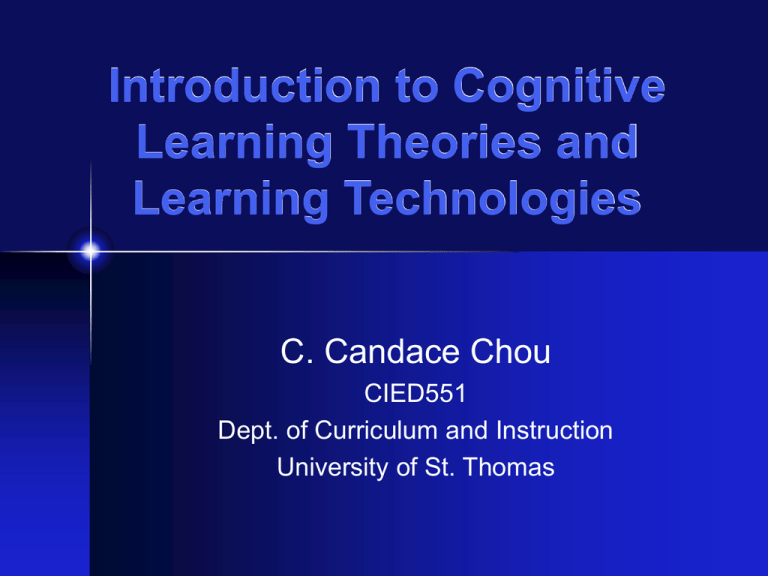
Introduction to Cognitive Learning Theories and Learning Technologies C. Candace Chou CIED551 Dept. of Curriculum and Instruction University of St. Thomas Skinner Behaviorist Theories • Before Skinner, learning theories are dominated by Pavlov’s classical conditioning concepts, S -> R • Skinner identified three kinds of conditions that shape behavior • Positive reinforcement • Negative reinforcement • Punishment Behaviorist Theories • Implications for education • Teaching is a process of arranging contingencies of reinforcement effective to bring about learning. • Implications for technology integration • Drill-and-practice software • Praise correct answers to tutorial software • Memorization of basic information Information-Processing Theory: The Mind as Computer • Based on a model of memory and storage proposed by Atkinson & Shiffrin, 1968 • The brain contains certain structures that process information like a computer • Human brain has three kinds of memory or “stores” • Sensory registers: the parts receive all information • Short-term memory (STM): working memory • Long-term memory (LTM): hold information indefinitely Information-Processing Theories II • Implications for education • Ask interesting questions and display eyecatching materials to draw student attention • While presenting information, give instructions that point out the keys of the new learning materials • Give students practice exercises to help assure the transfer of information from short- to long-term memory Information-Processing Theories III • Implications for technology integration • Artificial intelligence (AI) applications, an attempt to develop computer software that can simulate the thinking and learning behaviors of humans. • Drill-and-practice software helps students encode and store newly-learned information into long-term memory Gagné: Principles of Instruction • • Translate behaviorist and information processing theories into instructional strategies Types of learning 1. Intellectual skills (problem solving, higherorder thinking, defined concepts, concrete concepts, discriminations) 2. Cognitive strategies 3. Verbal information 4. Motor skills 5. Attitudes Gagné II • Events of instruction 1. 2. 3. 4. 5. 6. 7. 8. 9. Gain instruction Informing the learner of the objectives Stimulating recall of prerequisite learning Presenting new materials Providing learning guidance Eliciting performance Providing feedback about correctness Assessing performance Enhancing retention and recall Gagné III • Learning hierarchies: Learning is a building process that the lower-level skills provide the foundation for higherlevel skills. • Math example: to work with long division problems requires the prerequisite math skills in number recognition, number facts, simple addition and subtraction, multiplication, and simple division. Gagné IV • Implications for education • Widely used to develop systematic instructional design principles • Sequence skills • Implications for technology integration • Plan lesson for instructional software such as drill, tutorial, simulation. • Tutorial could be stand-along and accomplish all of the events of instruction Vygotsky: Social Constructivism • Cognitive development is the result of social interactions in cultural contexts. • Focus on social factors in knowledge construction • Zone of proximal development: the difference between difficulty level of a problem child can cope with independently and the level that can be accomplished with adult help. • Cognitive changes takes place in the “construction zone.” Vygotsky II • Instructional Scaffolding: A teacher provides students with selective help (e.g. asking questions, directing attention, giving hints) to enable them to do things they could not do own their own. • Implications for technology integration: • Concepts of scaffolding and developing individual’s potential • Logo to virtual reality: using real-life examples relevant to individuals’ needs to advance student understanding. Vygotsky III • Implications for education: Davydov (1995) 1. Education is intended to develop children’s personalities 2. The human personality is linked to its creative potential and education should be designed to discover and develop this potential to its fullest in each individual. 3. Teaching and learning assume that students master their inner values through some personal activities. 4. Teachers direct and guide the individual activities of the students but they do not force their will on them or dictate to them. 5. The most valuable methods for student learning are those that correspond to their individual developmental stages and needs, therefore the methods can not be uniform across students. Piaget: Stages of Development • Piaget believed that all children go through four stages of cognitive development • Sensorimotor stage (0 - 2) • Explore the world through senses and motor activities • Preoperational stage (2-7) • Capable of speech communication, number recognition, & self-control • Concrete operational stage (7 - 11) • Capable of abstract reasoning and observation tasks • Formal operations stage (12 - 15) • Can form hypotheses, organize information & reason Piaget II • Ormrod (2000) summarized: 1. Children are active and motivated learners 2. Children’s knowledge of the world becomes more integrated and organized over time 3. Children learn through the process of assimilation and accommodation 4. Cognitive development depends on integration with one’s physical and social environment 5. The processes of equilibration (resolving disequilibrium) help to develop increasing complex levels of thought 6. Cognitive development can occur only after certain genetically controlled neurological changes occur 7. Cognitive development occurs in four qualitatively different stages. Piaget III • Implications for education • More of a philosophy • Need more concrete examples in explaining abstract concepts • Implications for technology integration • Logo simulation for learning programming • Real-world simulation before real-life experience Seymour Papert: Turtles and Beyond • Integrating the control of a robot in the shape of a turtle on screen into the Logo language. • Implications in education and technology • Discovery learning and “powerful ideas”: allow children to teach themselves with Logo and develop powerful ideas • Logo and the microworlds concept: allow children to see the cause and effect between programming commands and the pictures that result. He called microworld the “incubator of knowledge.” Cognition & Technology Group at Vanderbilt (CTGV) • Based on constructivism • Preventing inert knowledge: Inert knowledge is knowledge that can usually be recalled when people are explicitly asked to do so, but is not used spontaneously in problem solving even though it is relevant. CTGV II • Situated cognition and the need for anchored instruction • Teachers can prevent the problem of inert knowledge by situating learning in the context of what they called authentic experiences and practical apprenticeships • “Anchored instruction provides a way to recreate some of the advantages of apprenticeship training in formal educational settings CTGV III • Building knowledge through generative activities • Learning is most meaningful when it builds (scaffolds) on experiences they have already had. • Students are also most likely to remember knowledge that they build or “generate” themselves, rather than that which they simply receive passively. • Implications: Video-based scenarios posing interesting but difficult problems for students to solve, e.g. Jasper Woodbury Problem Solving series. Gardner: Multiple Intelligences • Types of intelligence • • • • • • • • Linguistic Musical Logical-mathematical Spatial Bodily-kinesthetic Intrapersonal Interpersonal Naturalist Gardner II • Implications for education and technology • IQ tests may not be the best way to just a given student’s ability to learn. • Intelligent behavior is likely to take different forms in children from different ethnic backgrounds. • Distributed intelligence: each student makes a different, but valued contribution to creating a product or solving a problem • Group collaboration among students of different intelligences Schema Theories • Schema are ... • Scripts of plays (Schank & Abelson, 1977) • Chunks of knowledge stored by patterns, structures, and scaffolds (West et al., 1991) • Can be “instantiated” by specific examples of concepts or events (Bruning et al., 1995) • Schema activation of learner’s prior knowledge in similar fields , building upon previous knowledge • Advance organizers employ the structure of materials that learners are familiar with • Implications • Web-based instruction • Computer-based instruction Meaningful Learning • • • • Active (Manipulative/Observant) Constructive (Articulative/Regulatory) Authentic (Complex/Contextual) Cooperative (Collaborative/Conversational) Educational Technologies • 1950s-1970s • Slide projector • Radio • Educational Television • 1980 • Drill-and-practice on computers • Productivity tools (desktop publishing, word process, graphics programs • 1990 • • • • Communication and multimedia production Computer-mediated communication systems Audio-video conferencing systems Virtual Reality What is Learning Technology? Your Definitions: Learning Technologies Engage learners in • Knowledge construction, not reception • Conversation, not reception • Articulation, not repetition • Collaboration, not competition • Reflection, not prescription (Jonassen et. al., 1999) References • Bruning, R. H., Schraw, G., J. & Ronning, R. R (1995). Cognitive Psychology and Instruction. Merrill Prentice Hall. • Roblyer, M. D. & Edwards, J. (1999). Integrating Educational Technology into Teaching. Merrill Prentice Hall. • Jonassen, D. H., Peck, K. L., & Wilson, B. G. (1999). Learning with Technology: A Constructivist Perspective. Merrill Prentice Hall.

